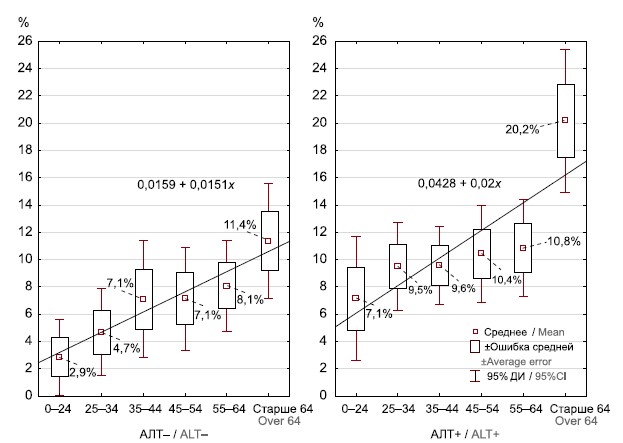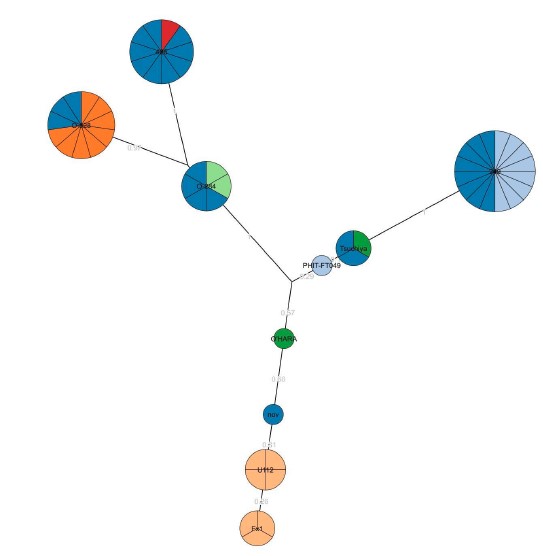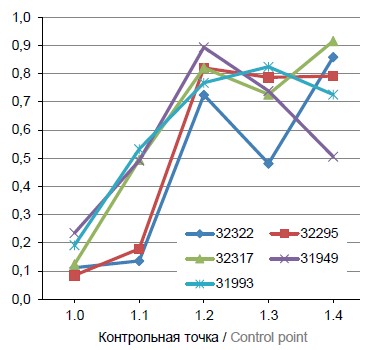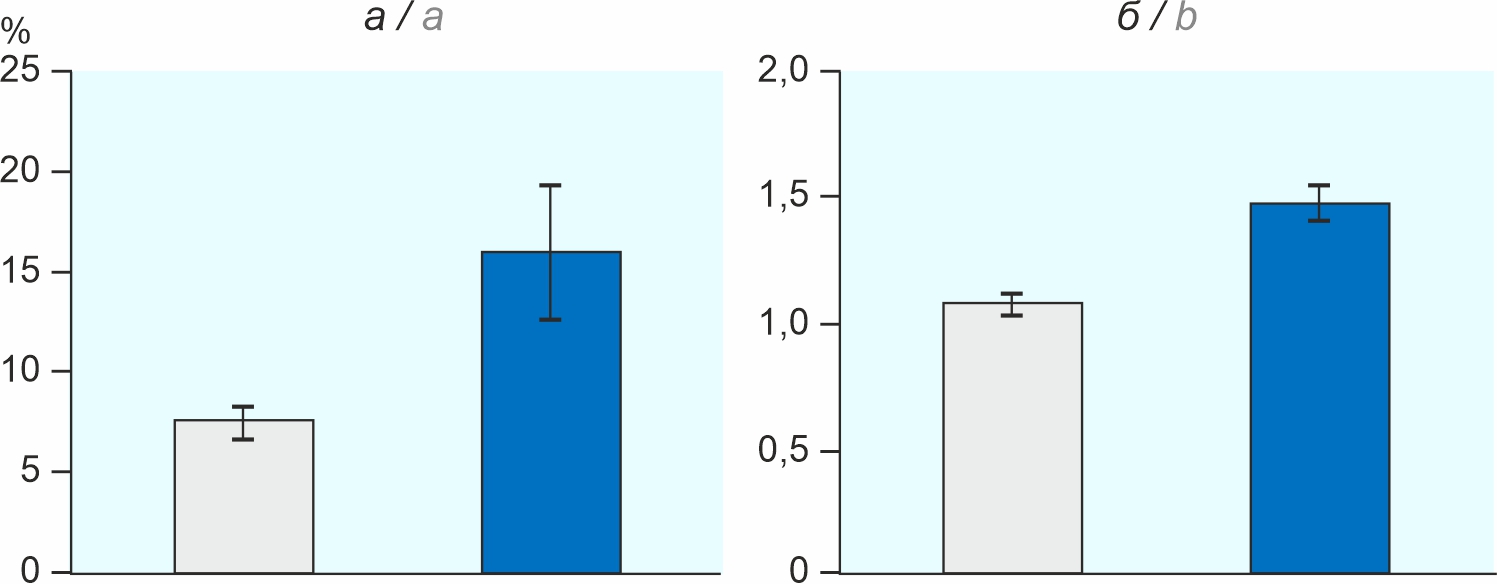Vol 99, No 2 (2022)
- Year: 2022
- Published: 15.05.2022
- Articles: 11
- URL: https://microbiol.crie.ru/jour/issue/view/49
Full Issue
ORIGINAL RESEARCHES
Evaluation of the epidemiological significance of molecular genetic factors in relation to the intensity of post-vaccination immunity against hepatitis B
Abstract
Introduction. Hepatitis B retains the status of socially significant infection and remains a major health problem worldwide, including the Russian Federation. The improvement of the effectiveness of the current complex of preventive measures, especially vaccination, is an important task for public health. Although vaccination against hepatitis B is highly successful, 5% to 10% of individuals do not experience a response to vaccine with an adequate level of antibodies to hepatitis B surface antigen (anti-HBs). One of the key factors determining the absence or insufficiency of post-vaccination immunity against hepatitis B may be the single-nucleotide polymorphisms (SNPs) that change gene sequences, including those that determine the mechanism of immunogenesis. Such genetic changes may affect the signaling pathways and result in significant decrease in antibody response to hepatitis B vaccine. Assessment of epidemiological significance of such SNPs is an important task, considering its possible associations with failure to respond adequately to vaccination.
The aim of the study was to determine the effect of SNPs of IL1B (rs1143634, rs1143627), IL1RN (rs4251961, rs419598), IL6 (rs1800795), IL10 (rs1800896), TULP1 (rs9380516), TLR4 (rs4986790), MERTK (rs4374383) genes on the formation of post-vaccination immunity against hepatitis B.
Materials and methods. Healthcare workers (n = 271) of the Treatment and Rehabilitation Center of the Ministry of Health of the Russian Federation with known vaccination history, data on age, work experience and department of the medical institution were included in this research. The presence and levels of anti-HBs and anti-HBcore IgG antibodies were determined by the ELISA method using the DS-ELISA-ANTI-HBs and DS-ELISA-ANTI-HBc kits, according to the manufacturer’s instructions. Genotyping was performed by real time polymerase chain reaction. Statistical analysis of data was carried out using the "Statistica 6.0" software.
Results. Statistically significant differences in the frequencies of CC (rs9380516) genotypes (p = 0.034; OR 0.497; 95% CI 0.261–0.949) and CT (p = 0.044; OR 1.967; 95% CI 1.015–3.812) of the TULP1 gene in the group of individuals with anti-HBs concentrations of 10–100 IU/l were found in association with the intensity of the post-vaccination response against hepatitis B. Also, for this group, differences were found in the structure of the TT/CT genotype pair of IL-10/TULP1 genes (rs1800896/rs9380516) (p = 0.003; OR = 5.39; 95% CI 1.7–17.4) and for the combination of AA/TT SNP MERTK/IL1RN genotypes (rs4374383/rs4251961) (p = 0.003; OR = 7.96; 95% CI 1.7–37.6).
Conclusion. Our study revealed that above variants of genotypes could play a role in predicting an increased risk of low (or absence) post-vaccination immune response against hepatitis B. It seems appropriate to use the relationship between the gene polymorphisms and a low concentration of post-vaccination anti-HBs antibodies in assessing scenarios for the development of the epidemic process of hepatitis B, since the identified associations allow to quantify the risks of poor herd immunity against this infection.
 149-159
149-159


Assessment of neutrophil degranulation intensity and changes in neutrophil phenotype by FCᵧRIIIB expression level in blood of patients with COVID-19 and convalescents
Abstract
Introduction. Disease severity in hospitalized COVID-19 patients correlates with the relative content in the blood of a specific low-density neutrophilic granulocyte (NG) population, whose cells are characterized by reduced granularity, high heterogeneity in the expression of FcᵧRIIIb (CD16) and a tendency to spontaneous autolysis (netosis).
The aim of the study was to compare the intensity of NG degranulation and the FcᵧRIIIb expression by these cells in blood of patients with COVID-19 and convalescents.
Materials and methods. The blood leukocytes of 40 patients diagnosed with COVID-19, 33 convalescents and 20 healthy donors (control) were examined using flow cytometry. To identify NG (CD16+-granulocytes) and to assess the surface expression of the netosis molecular trigger (FcᵧRIIIb), a single-color reagent of labeled monoclonal antibodies CD16-FITC was used. Immunophenotyping of lymphocytes was performed using two four-color reagents. In addition, cell debris content was determined in each Lyse/No-Wash-stained whole blood sample. The presence of neutrophils at the stage of netosis was confirmed by microscopy. Cytokine production was determined on an automatic enzyme immunoassay analyzer.
Results. Against the background of characteristic changes in the lymphocyte subpopulation composition and cytokine production, in blood of COVID-19 patients with acute pneumonia, hypoxia and tachycardia a more intense degranulation of NG (2.6 times), higher degree of CD16 expression heterogeneity (1.8 times) and an increased leukocytolysis intensity (1.6 times) were observed compared to convalescents who have undergone severe and moderate forms of the disease. In convalescents, the degree of differences of these indicators compared to control values varied in concordance with the disease severity.
Conclusion. The nature of changes in the parameters studied in COVID-19 patients in the acute phase of the disease and during the period of convalescence confirms the possible mechanism of the development of complications due to an imbalance between the activity of elastase released from NG granules and its plasma inhibitor α1 -antitrypsin.
 172-184
172-184


Prevalence of antibodies to the hepatitis E virus in the population of the Republic of Belarus
Abstract
Rationale. Hepatitis E (HE) is a zooanthroponosis. Domestic pigs are the main reservoir for hepatitis E virus (HEV) in the Republic of Belarus (RB). Considering the well-developed pig farming, there is a high risk of infection spread among the population; however, the scale of virus circulation and patterns of HE epidemiology in the above region are still insufficiently explored.
The aim of the study is to assess HEV seroprevalence specific for the HE epidemic process in RB.
Materials and methods. Serum samples (n = 2,784) collected from patients of infectious disease departments at hospitals (n = 1,669) and relatively healthy people (n = 1,114) from different RB regions were used to measure the activity of alanine aminotransferase (ALT) by a kinetic rate method as well as IgG antibodies to HEV by the enzyme-linked immunosorbent assay (ELISA).
Results. In the group of healthy people, anti-HEV IgG were detected in 7.3% (95% CI, 5.8–9.0). In the group of patients with liver disorders, the detection frequency was significantly higher, reaching 11.2% (95% CI, 9.6–12.9). In the groups of healthy people and patients with elevated ALT levels, the HEV seroprevalence did not depend on their gender or the region of residence. The anti-HEV IgG detection frequency gradually increased among olderage patients and reached the peak levels (15.9% on average) in the over-64 age group.
Conclusions. RB is characterized by intensive HEV circulation, while the HE epidemic process is characterized by a latent nature. The actual prevalence of HЕ seromarkers among the RB population exceeds the frequency of diagnosed cases, suggesting insufficient vigilance of healthcare workers towards HE and subclinical forms of infection in most of the patients.
 160-171
160-171


The utility of real-time PCR as a test for confirmation of the absence of residual neurovirulence of strains for live antiviral vaccines
Abstract
Introduction. Taking into account the particular importance of the assurance of the safety of antiviral vaccines containing, albeit attenuated, but live viruses, that can possibly retain the residual neurovirulence, it is important to develop additional tests to confirm the stability of attenuation using modern methods of laboratory diagnostics.
The aim of the study was to assess the possibility of using the RT-PCR method as an additional test for monitoring the residual neurovirulence of attenuated rubella virus vaccine strains.
Materials and methods. We used live attenuated vaccine strains of rubella virus "Orlov-V" and RA27/3. The study was carried out on 11 clinically healthy monkeys of the species Macaca mulatta weighing 3–5 kg, born and kept in the nursery of the Research Institute of Medical Primatology. The clinical material studied was tissue samples from various parts of the central nervous system (CNS), regional lymph nodes, parenchymal organs, plasma and cerebrospinal fluid of experimental animals. Control of extraneural dissemination of vaccine strains was carried out using virological (cytopathic action) and molecular biological methods (RT-PCR).
Results. The absence of an infectious virus in the CNS, peripheral organs and blood plasma of monkeys infected with vaccine strains was demonstrated, which indicates a high level of attenuation of rubella virus strains "Orlov-B" and RA27/3. The analytical sensitivity of the RT-PCR method was found to exceed the analytical sensitivity of the cytopathic reaction by 1.7–3.3 lg when determining the content of rubella virus in the tissues of the CNS and peripheral organs of inoculated animals.
Conclusion. Comparative analysis of experimental data showed that the detection of rubella virus by real-time PCR has a number of advantages due its specificity, sensitivity and a shorter turnaround time. In this connection, the RT-PCR method can be used as an additional test in the preclinical assessment of specific safety, namely, extraneural dissemination of attenuated vaccine strains, which is essential for quality and safety control of live rubella vaccines.
 185-192
185-192


Differentiation of the Francsella tularensis subspecies by the INDEL typing method
Abstract
Background. Francisella tularensis, the etiological agent of tularemia, belongs to the facultative intracellular pathogens that cause severe disease in humans and man species of animals, and is a category A bioterrorism agent. Currently, F. tularensis is divided into four subspecies: F. tularensis subsp. tularensis (nearctica), F. tularensis subsp. holarctica, F. tularensis subsp. mediasiatica, F. tularensis subsp novicida, which differ in their pathogenicity and geographical distribution. Historically, this division was due to the different distribution area of strains, their differences in biochemical activity and pathogenicity for different hosts. The biochemical identification of subspecies is very laborious and requires work with live cultures of the microorganism, which determines the need to develop new molecular genetic approaches for genotyping F. tularensis strains.
The aim of this study is to develop a method for differentiating subspecies and individual groups of F. tularensis based on INDEL typing. Research objectives: creation of a local database of nucleotide sequences of F. tularensis strains of different subspecies, search for INDEL markers that are significant for the differentiation of subspecies of the causative agent of tularemia, designing primers for the detection of INDEL markers using PCR, optimization of the set of INDEL markers and elucidation of phylogenetic relationships between the studied strains based on the proposed INDEL typing method.
Materials and methods. The local database of nucleotide sequences of F. tularensis strains of different subspecies for comparative analysis of F. tularensis genomes presented in the GenBank database was created using the author's software. Detection of INDEL markers in the genomes of strains of the local database was carried out using the GeneExpert program. Primer design and in silico PCR were performed using the Primer3Plus software and the proprietary VirtualPCR software. Cluster analysis and construction of a phylogenetic tree were performed using the GrapeTree program.
Results and discussion. The implementation of the proposed five INDEL markers for genotyping of 29 studied strains of different subspecies from the GenBank database made it possible to detect 9 individual genotypes with a high diversity index (DI = 0.85). Not only the corresponding division of the tularensis, holarctica, mediasiatica, and novicida subspecies into different clusters was noted, but also the intraspecific division into groups of strains was observed. Differentiation of F. tularensis subspecies was confirmed in vitro for the collection of strains of different subspecies of the Collection of Living Cultures of the Rostov-on-Don Plague Control Researsh Institute.
Conclusion. For the first time, the F. tularensis subspecies differentiation system based on the INDEL typing method has been developed, which allows in vitro identification of both F. tularensis subspecies (tularensis, holarctica, mediasiatica and novicida) and groups of strains within subspecies without the need for strain sequencing. The method is protected by a patent. The topology of the INDEL phylogenetic tree of genotypes of F. tularensis strains correlates with the patterns of evolution of the tularemia microbe presented earlier. The proposed method can be used for combined typing of F. tularensis strains together with MLVA or SNP typing
 193-202
193-202


Safety and immunogenicity of live intranasal pertussis vaccine GamLVP in the experimental infant hamadryas baboon model
Abstract
Introduction. The Gamaleya National Center of Epidemiology and Microbiology has developed a live intranasal pertussis vaccine, GamLVP, for protection against whooping cough. It is indicated for vaccination of infants and revaccination of adults of all age groups. Preclinical studies on suckling mice or rats and adult monkeys as well as clinical trials involving adult volunteers demonstrated safety and efficacy of the GamLVP vaccine. The expansion of the GamLVP vaccine to be used for vaccination of infants requires additional preclinical studies to assess its safety and immunogenicity in the most suitable experimental model of infant hamadryas baboons (Papio hamadryas).
The aim of the study was to assess safety and immunogenicity of the GamLVP vaccine administered intranasally for a single dose, two-dose, and three-dose immunization of P. hamadryas infants.
Materials and methods. The study was performed in three 1–2-month-old P. hamadryas infants kept, together with their mothers, in a separate cage. The results of the complete blood count and biochemical profile tests were measured before and after the immunization and experimental infection. The enzyme immunoassay (EIA) was used to detect any changes in the levels of specific IgG antibodies in sera from the mothers and infants; the agglutination test (AT) was used to measure titers of total anti-pertussis antibodies.
Results. The intranasal immunization of P. hamadryas infants with the GamLVP vaccine triggered development of a specific humoral immune response mediated by IgG antibodies (pertussis toxin + filamentous hemagglutinin), increased titers of total agglutinating anti-pertussis antibodies, caused no local and systemic reactions, caused no changes in the complete blood count and biochemical profile. The experimental infection of the GamLVPimmunized P. hamadryas infants did not cause any changes in the laboratory blood test values and any clinical manifestations typical of the pertussis infection.
 203-214
203-214


The study of flaviviruses and Chikungunya virus seroprevalence in Nicaragua — virus-specific antibody avidity assay as a tool for differential diagnosis
Abstract
Introduction. Arboviral infections are a rising public health concern not only for some individual countries, but also for the entire world due to the repeated outbreaks over the past decade.
The aim was to conduct a seroprevalence study of Dengue (DENV), Zika (ZIKV), Yellow fever (YFV) and Chikungunya (CHIKV) viruses using a limited number of samples in Nicaragua.
Materials and methods. Total 200 serum samples collected previously in Nicaragua were analyzed simultaneously. Commercially available diagnostic kits, as well as in-house methods were used. The avidity of antibodies (IgG) in positive serum samples was assessed after the treatment with 8M urea.
Results. 85 serum samples (42.5%) contained IgG antibodies to one or several viruses simultaneously. IgG antibodies only to one virus were detected in 46 serum samples (23%) with the avidity index (AI) ≥ 30%. Among 39 samples (19.5%) that contained IgG antibodies to several viruses, only in 19 samples (9.5%) IgG antibodies with high AI (≥ 30%) to several viruses were detected. In 16 serum samples (8.0%), IgG antibodies to DENV with a high AI and antibodies to ZIKV and/or YFV with a low AI < 30% were detected.
Discussion. The results obtained in ELISA testing were corrected, since only IgG antibodies with a high AI confirm the past infection. The analysis of the specific IgG antibody avidity helped not only to confirm the cases of combined or sequential infection in the past, but also to discriminate the cross-reactive IgG antibodies induced by closely related DENV, ZIKV and YFV. The presence of cross-reactive IgG antibodies, on the one hand, make it difficult to determine the real seroprevalence of flavivirus infections, and, on the other hand, may increase the risk of antibody-dependent enhancement (ADE) of the disease, which is well-known for the secondary Dengue fever and for the consecutive infection with DENV and ZIKV.
Conclusion. The analysis of virus-specific antibody avidity made it possible not only to distinguish recent from the past infection, but also to discriminate the cross-reactive antibodies with the low avidity.
 215-224
215-224


Activity of peripheral blood factors against Candida albicans
Abstract
Introduction. Currently, the colonization of various human biotopes by yeast-like fungi of the genus Candida is considered a relatively frequent phenomenon. At the same time, the clinical manifestations of the inflammatory process do not develop in every case, which implies the formation of a unique symbiosis between microscopic fungi and cells of the human body, the maintenance of which largely depends on the activity of the immune system. The main part of researches on the antifungal activity of the human immune system is concentrated around pathological conditions, and practically no attention is paid to such in healthy individuals. It has been shown that human immunity factors can, on the one hand, for example, contribute to the formation of C. albicans biofilms, and, on the other hand, take an active part in their destruction.
The aim of the investigation was to evaluate the candidacid, antibiofilm, phagocytic and radical-producing activities of peripheral blood of healthy donors using C. albicans cells as an object.
Materials and methods. Peripheral blood samples were obtained from 32 healthy donors, mycidal activity, absorption and radical-producing abilities of leukocytes, as well as the effect of blood serum on film biomass were assessed. For opsonization of C. albicans cells, immunoglobulins G were used according to the previously approved method.
Results. A weak mycocidal activity of the peripheral blood of healthy donors was shown. Opsonization of C. albicans with immunoglobulin G significantly increases this blood function. In the early phase of contact with C. albicans, yeast-like cells mainly absorb by neutrophilic leukocytes, and mononuclear cells practically do not participate in the process of phagocytosis, probably their activity manifests itself in a later period. Opsonization of C. albicans stimulates the absorption activity of leukocytes, which is reflected in an increase in the average number of absorbed objects per leukocyte. It has been shown that opsonins can participate in enhancing the radical-producing activity of leukocytes. Thus, inactivation of proteins of the complement system levels the stimulating effect of C. albicans opsonization.
Conclusion. Immunoglobulins G and proteins of the complement system make a significant contribution to the suppression of the pathogenic activity of C. albicans.
 225-230
225-230


REVIEWS
The role of cyanotoxins in human and animal pathology (а review)
Abstract
Cyanobacteria are the oldest and most widespread form of life on Earth. Many of them produce toxins that are dangerous to humans and animals. The review presents data on the distribution of toxin-producing cyanobacteria, the pathogenesis of the action of toxins on human and animal cells and tissues. A significant consideration is given to the neurotoxic effect of cyanotoxins, which is most common cause of animal death. Cyanotoxins can cause severe damage to the central and peripheral nervous systems, as well as the liver, kidneys, reproductive system and digestive tract. Data on hepatotoxic, nephrotoxic, cardiotoxic, immunotoxic effects of cyanotoxins are presented. Their role in the human brain degenerative diseases is considered. The possible influence of cyanotoxins on carcinogenesis, especially in the liver, large intestine and rectum, is evaluated. The limitations of the existing data on the pathogenicity of cyanobacteria and medical care necessary for cyanotoxin-induced diseases are noted. The necessity for further studies of clinical manifestations of pathological processes caused by cyanotoxins, the development of diagnostic methods and specific therapy of poisoning is discussed.
 231-243
231-243


Purulent-septic infections in puerperas. Part 2. Clinical and pathogenetic characteristics of nosological forms, etiology and antibiotic resistance (literature review)
Abstract
Despite the improvement of the obstetric care system, purulent-septic infections (PSI) of puerperas and the associated maternal mortality do not lose relevance at the present time. This study analyzed publications on the following information resources: eLibrary, Google Scholar, PubMed, NCBI on the clinical and pathogenetic characteristics of postpartum GSI (sepsis, peritonitis, endometritis, mastitis, and surgical site infections (SSI)) and their leading pathogens. It should be said that the clinical picture of PSI in the postpartum period does not always correspond to the degree of activity of the infectious process, which leads to late diagnosis of the local focus of infection and, in the future, to its generalization. A modern feature of the PSI of puerperas is their polyetiology, with a predominance of opportunistic microorganisms, the role of individual representatives of which is far from unambiguous and requires discussion. In recent years, the etiological and epidemiological significance of gram-negative microorganisms of the Enterobacteriaceae family, including those with multidrug resistance, has been increasing. Thus, despite a sufficient amount of information on the etiology and clinical and pathogenetic features of PSI in the postpartum period, an interdisciplinary approach is needed to study this problem with the participation of different specialists: obstetricians-gynecologists, microbiologists, clinical pharmacologists and epidemiologists.
 244-259
244-259


OBITUARIES
 260-262
260-262















